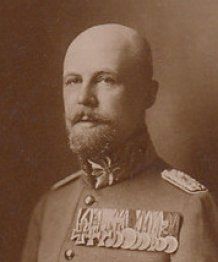Prince Joachim Albrecht of Prussia
Prince Joachim of Prussia was born on 27 September 1876 in Hannover (Germany). His full name was "Wilhelm Friedrich Karl Ernst Joachim Albrecht Prinz von Preußen" and he was a member of the House of Hohenzollern. Prince Joachim was the second eldest son of Prince Albert of Prussia (1837-1906) and his wife Princess Marie of Saxe-Altenburg (1854-1898).
Prince Joachim studied law at the University of Bonn. But like all male Hohenzollerns, Joachim entered the army after his studies and became officer at the 4th Queen Augusta Guards Grenadiers. In World War I Prince Joachim served as a lieutenant colonel and was seriously injured. He then focused on composing music.
On 3 September 1919, Prince Joachim married Marie Blich-Sulzer, but the marriage was never recognized by the family. He married secondly to Karoline Kornelia Stockhammer on 9 October 1920 in Vienna. He and Karoline divorced in 1936. Prince Joachim died three years later, on 24 October 1939 in Berlin.
Music and especially composing appealed to Prince Joachim since his student days and he already made a name for himself composing at that time. In 1898, he presented a military waltz he wrote to a family gathering. An orchestra played it, while Emperor Wilhelm conducted it. In 1905, he wrote the libretto and pantomime for "The Apple of Paris", which was well received in Berlin. He also composed ballets and symphonies, and he also was an accomplished violin and cello player. He described himself as old-fashioned, especially in relation to music. He stated in 1927 that he was old-fashioned "because I am a thoroughly healthy individual. Much modern music is unnatural and discordant because composers and audiences have jaded nerves which need stirring up. I want my hearers to leave my concerts with the feeling that I have furnished them with esthetic delight and instilled harmony and beauty into their souls".
In 1926, Joachim accepted an invitation to present his compositions in a series of concerts in leading American cities. He received this invite after playing in a number of welfare concerts in Berlin, and conducting his own works throughout the previous summer in Central Germany. One such concert was planned for Newark, in which Joachim would be conducting an orchestra to music written by himself. All of these concerts would have been done for various charitable organizations. After his arrival in the United States however, it soon emerged that he would do no performing while in the country.
In my possession are two autograph manuscripts of unpublished compositions by Prince Joachim Albrecht of Prussia. The two compositions are "Tango 1926" and "Der Schönsten", both for small orchestra.
I obtained these manuscripts from an US source and they date from 1926 resp. 1927. So these scores were most likely sent to the US in preparation of the announced welfare tour through American cities. The address label of the package did not survive completely, but one can still read that it was sent from "Berlin W 62, Budapester Straße 2" (the private address of the Prince) to a "Dr. M. W. Sullivan" in New York.
Tango 1926
The "Tango 1926" is scored for a small ensemble of harmonium, violin 1, violin obligato, cello, bass and tenor banjo. The parts are handwritten copies made by Mischa Michaeloff, but the title page of the piano part is written and signed by Prince Joachim.
Mischa Michaeloff was a Russian composer who studied in Berlin at that time. According to his mark on piano part, Mischa Michaeloff lived Berlin W 50, Steinplatz 14162. He later moved to England, became a British citizen and made several recordings of light music with his "gypsy orchestra". He also used the pseudonym "Mischa Sissermann".
Der Schönsten
"Der Schönsten" is a Valse Boston and again scored for a small ensemble, that now consists of piano, violin 1, violin obligato, cello, bass, flute, clarinet, saxophon, trumpet, trombone and timpani. The work dates from 1927. Again the piano part is an autograph of Prince Joachim, the handwritten copies for the other parts now were made by the "Notenschreib-Büro Dr. Wohlauer, Berlin W. 50, Ansbacher Straße 8".
Adolf Wohlauer was a composer and his sheet music copy service was well-known in Berlin in the 1920s and 1930s.
